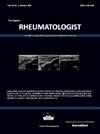Evolving role of long non-coding (lnc) RNA RP11-273G15.2, mRNA-RSAD2 and mRNA-IFI44 in systemic lupus erythematosus patients
IF 1
Q4 RHEUMATOLOGY
引用次数: 0
Abstract
Aim of the work: To assess expression level of long non-coding (lnc) RNA RP11-273G15.2, microRNA (mRNA) RSAD2, and mRNAIFI44 in systemic lupus erythematosus (SLE) patients and to study their relationship with clinical manifestations, hematological indices, and disease activity. Patients and methods: This study recruited 40 SLE patients and 40 controls. SLE disease activity index (SLEDAI) was assessed. Quantitative analysis by real-time polymerized-chain reaction was accomplished for lncRNA RP11-273G15.2, mRNA-RSAD2 and mRNA-IFI44. Results: The mean age of the patients was 33.4 ± 8.1 years, 36 females (F:M 9:1) and disease duration 7.4 ± 6.2 years. The mRNA IFI44 was significantly upregulated in patients (p = 0.004), while lnc RNA RP11-273G15.2 and mRNA-RSAD2 were comparable between patients and controls. The lnc RNA RP11-273G15.2, mRNA IFI44 and mRNA RSAD2 were similar between patients with and without musculoskeletal, cardiac, pulmonary, mucocutaneous, central nervous system, or renal manifestations. The mRNA RSAD2 exhibited significantly lower expression level in patients with history of thrombosis (p = 0.03). The lnc RNA RP11-273G15.2, mRNA-IFI44 and mRNA-RSAD2 were comparable in relation to the other blood indices anti-dsDNA positivity and complement consumption. There was no association of any of the studied parameters with SLEDAI. Conclusion: The mRNA IFI44 was significantly upregulated in SLE patients signifying its role in the molecular pathophysiology of SLE, while lncRNA RP11-273G15.2, and mRNA-RSAD2 were comparable between patients and controls. The lncRNA RP11-273G15.2, mRNA-IFI44 and mRNA-RSAD2 were not related to clinical manifestations, hematological indices, immune profile, or disease activity of SLE patients, apart from significant down regulation of mRNA-RSAD2 in patients with history of thrombosis.
长链非编码RNA (lnc) RP11-273G15.2、mRNA-RSAD2和mRNA-IFI44在系统性红斑狼疮患者中的进化作用
研究目的:评估长链非编码RNA (lnc) RP11-273G15.2、microRNA (mRNA) RSAD2、mRNAIFI44在系统性红斑狼疮(SLE)患者中的表达水平,并探讨其与临床表现、血液学指标、疾病活动度的关系。患者和方法:本研究招募了40例SLE患者和40例对照组。评估SLE疾病活动指数(SLEDAI)。实时聚合链反应对lncRNA RP11-273G15.2、mRNA-RSAD2和mRNA-IFI44进行定量分析。结果:患者平均年龄33.4±8.1岁,女性36例(男女比例为9:1),病程7.4±6.2年。mRNA IFI44在患者中显著上调(p = 0.004),而lnc RNA RP11-273G15.2和mRNA- rsad2在患者和对照组之间具有可对比性。lnc RNA RP11-273G15.2、mRNA IFI44和mRNA RSAD2在有无肌肉骨骼、心脏、肺部、粘膜皮肤、中枢神经系统或肾脏表现的患者中相似。有血栓病史的患者RSAD2 mRNA表达水平明显降低(p = 0.03)。lnc RNA RP11-273G15.2、mRNA-IFI44和mRNA-RSAD2与其他血液指标抗dsdna阳性和补体消耗具有可比性。没有任何研究参数与SLEDAI相关。结论:mRNA IFI44在SLE患者中显著上调,参与SLE的分子病理生理,而lncRNA RP11-273G15.2和mRNA- rsad2在患者和对照组之间具有可比性。lncRNA RP11-273G15.2、mRNA-IFI44、mRNA-RSAD2与SLE患者的临床表现、血液学指标、免疫谱、疾病活动度均无相关性,但有血栓病史的患者mRNA-RSAD2明显下调。
本文章由计算机程序翻译,如有差异,请以英文原文为准。
求助全文
约1分钟内获得全文
求助全文

 求助内容:
求助内容: 应助结果提醒方式:
应助结果提醒方式:


